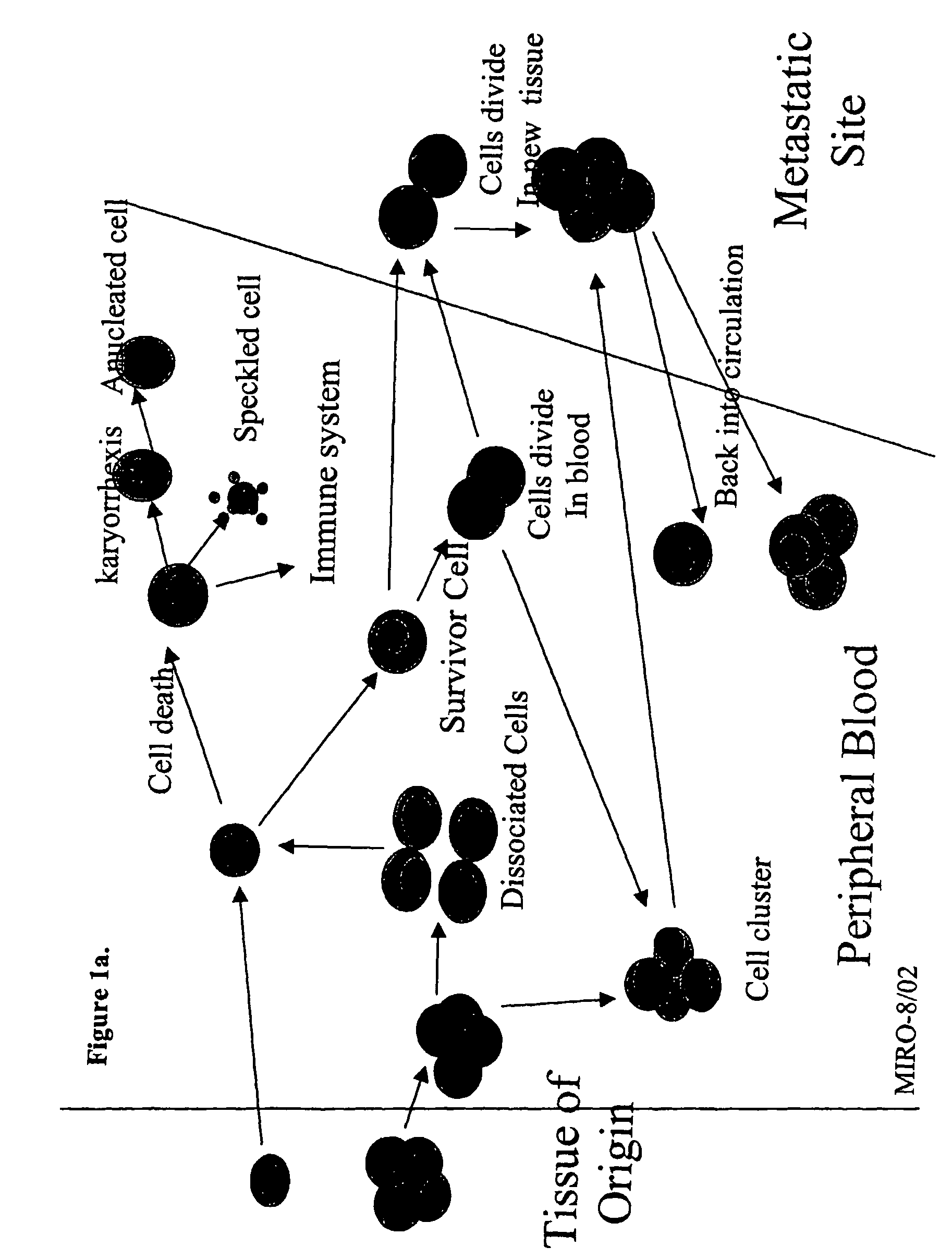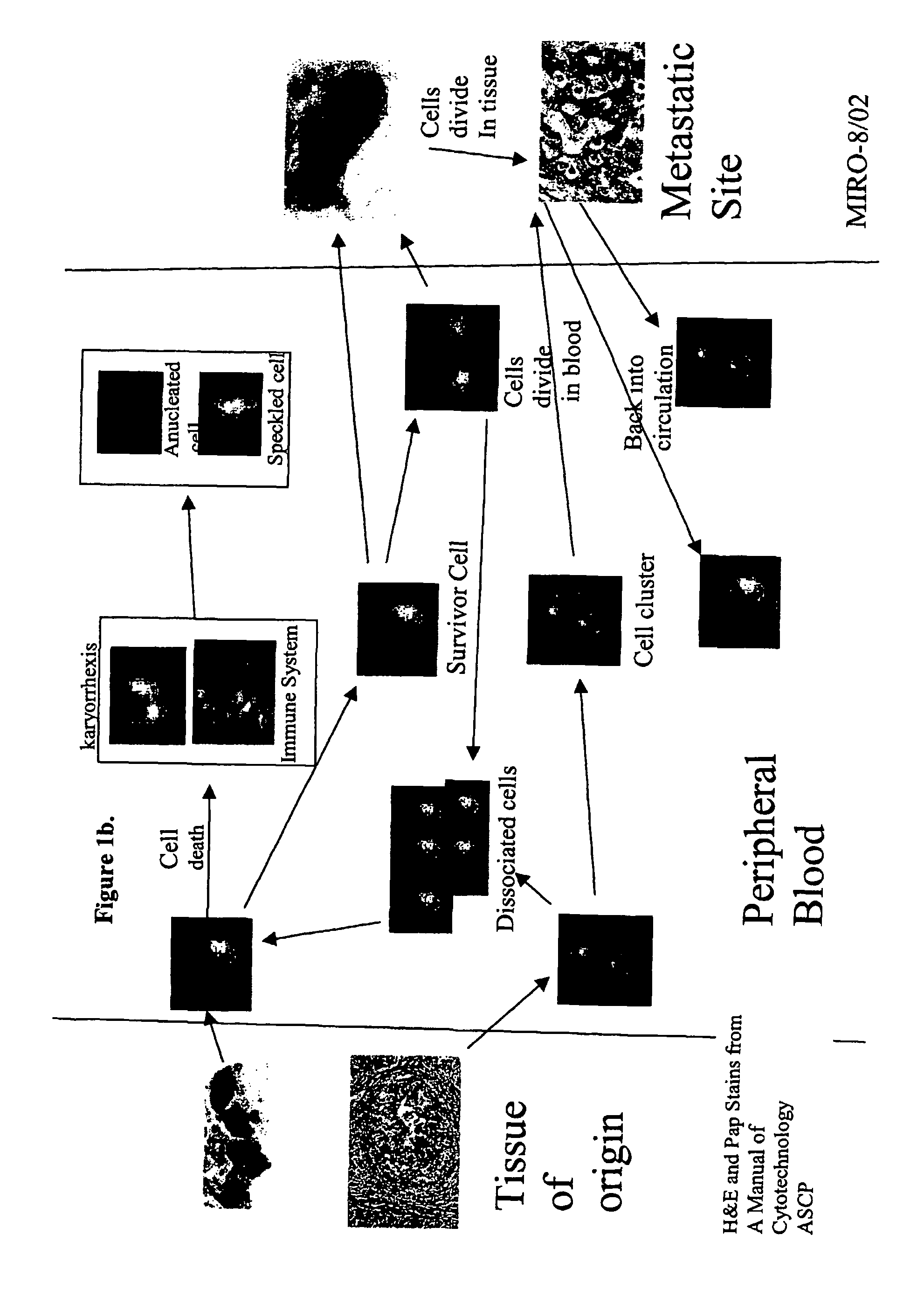Analysis of circulating tumor cells, fragments, and debris
a technology fragments, applied in the field of analysis fragments and debris, can solve the problems of spurious increase in the number of detected circulating cancer cells, increased cellular debris that can interfere, and increased the amount of circulating tumor cells. to achieve the effect of inhibiting further damage of
- Summary
- Abstract
- Description
- Claims
- Application Information
AI Technical Summary
Benefits of technology
Problems solved by technology
Method used
Image
Examples
example 1
Sample Analysis Via Flow Cytometry
[0107]Samples were analyzed on a FACSCalibur flow cytometer equipped with a 488 nm argon ion laser (BDIS, San Jose, Calif.). Data acquisition was performed with CELLQUEST analysis system (BDIS, San Jose, Calif.) using a threshold on the fluorescence of the nucleic acid dye. The acquisition was halted after 8000 beads or 80% of the sample was analyzed. Multiparameter data analysis was performed on the listmode data (Paint-A-GatePro, BDIS, San Jose, Calif.). Analysis criteria included size defined by forward light scatter, granularity defined by orthogonal light scatter, positive staining with the PE-labeled anti-cytokeratin MAb and no staining with the PerCP-labeled anti-CD45 Mab. For each sample, the number of events present in the region typical for epithelial cells was multiplied by 1.25 to account for the sample volume not analyzed by flow cytometry.
[0108]FIG. 2 Panels A, B and C shows the flow cytometric analysis of a blood sample of a patient w...
example 2
Sample Analysis Via CellSpotter®
[0109]The CELLSPOTTER system consists of a microscope with a Mercury Arc Lamp mercury arc lamp, a 10× objective, a high resolution X ,Y, Z stage and a-four filter cube changer. Excitation, dichroic and emission filters in each of four cubes were for DAPI 365 nm / 400 nm / 400 nm, for DiOC16 480 nm / 495 nm / 510 nm, for PE 546 nm / 560 nm / 580 nm and for APC 620 nm / 660 nm / 700 nm. Images were acquired with a digital camera connected to a digital frame grabber. The surface of the chamber is 80.2 mm2 and 4 rows of 35 images for each of the 4 filters resulting in 560 images have to be acquired to cover the complete surface. The CELLSPOTTER acquisition program automatically determines the region over which the images are to be acquired, the number of images to acquire, the position of each image and the microscope focus to use at each position. All the images from a sample are logged into a directory that is unique to the specific sample identification. An algorithm ...
example 3
CTC in Prostate Cancer Patients
[0112]CTC were enumerated in 18 blood samples of prostate cancer patients and 27 samples from healthy individuals by both flow cytometry and CELLSPOTTER system. The results shown in Table 1 were sorted by increasing number of intact CTC detected by the CELLSPOTTER system.
[0113]
TABLE 1Enumeration of CTC by the CELLSPOTTER system and flowcytometry in 18 blood samples of prostate cancer patients and 27samples from healthy individuals.FlowCellSpotter ®CytometryIntactDamagedTumor CellCK+CD45-PatientTumor CellsTumor CellsFragmentsNA+Sample#%#%#%# 1001501505 20021000012 3002661341 4002502500 5002295715 60036024018 7003385620 80074495610 9001376424210151520904111104405500122221116674132867144193691470516812120483683153223448134244875001635051122592493723173502142991441289242018742171122364181310Mean—4%—34%—62%—27 samples from healthy donorsMean0.040.964.960.7SD0.191.853.981.14Min0000Max17154# - number CTC in 7.5 ml blood% - percentage of all CTC detected by Ce...
PUM
| Property | Measurement | Unit |
|---|---|---|
| size | aaaaa | aaaaa |
| diameter | aaaaa | aaaaa |
| particle size | aaaaa | aaaaa |
Abstract
Description
Claims
Application Information
 Login to View More
Login to View More - R&D
- Intellectual Property
- Life Sciences
- Materials
- Tech Scout
- Unparalleled Data Quality
- Higher Quality Content
- 60% Fewer Hallucinations
Browse by: Latest US Patents, China's latest patents, Technical Efficacy Thesaurus, Application Domain, Technology Topic, Popular Technical Reports.
© 2025 PatSnap. All rights reserved.Legal|Privacy policy|Modern Slavery Act Transparency Statement|Sitemap|About US| Contact US: help@patsnap.com



